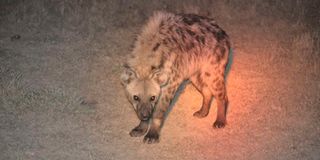Premium
Forgotten Wajir village where locals grapple with hyena attacks

Residents of Kiterere village, Migori County are living in fear of hyenas and wild dogs which come out at night to dig up shallow graves at the nearby Lichota public cemetery
In Abakdere village, Wajir County, Hussein Mahamed stares at his foot, which has bite marks.
He says he was attacked by a hyena a year ago, leaving him almost disabled.
“I was busy herding my livestock when out of nowhere a hyena tried to grab one of my goats. In my efforts to save it, I was bitten on my right leg.”
The 50-year-old man said the beast had decided that it would take either him or the goat.
“I tried shouting for help, but the hyena was very aggressive. It reached for my right hand and I still have the mark,” he said, pointing to the bite mark.
“It was either me or the goat. After some struggles, fellow villagers showed up to rescue me. I was rushed to Wajir Referral Hospital, where I was hospitalised for a month.”
The Kenya Wildlife Service (KWS) refused to compensate him, he says, and his family had to pay all his medical bills.
“I have tried several times to request compensation from KWS, but my efforts were in vain. It has been a year already,” he said, adding that he still feels pain in his leg and cannot walk far.
“My right hand cannot carry anything heavy.”
If hyenas don’t attack villagers, they go for their livestock.
Mahamed Omar, another villager, said he once lost 10 goats to a hyena two years ago. The goats were grazing near his homestead.
“We were in the house. Before we could notice what was happening, the aggressive animal had already killed 10 of my goats,” he said.
“I have been trying to follow up with KWS officials for compensation, but it has been two years of no success.”
Abdullahi Abdille Shahow, a researcher from the northeastern region, says weather conditions are partly to blame for these human-wildlife encounters.
“The wildlife attacks do not occur in Wajir only. They happen across the northeastern counties. There are other wild animals also, such as lions and warthogs,” he said.
“The issue is that during the dry season the water sources in the areas dry up, forcing wild animals and people there to compete for the basic need.”
People are in constant conflict with wild animals, he said. “Humans have also been neglected. No compensation is being given to them.”
Area Chief Dekow Ali says such incidents are common.
“We have tried several times to ask the Kenya Wildlife Service to intervene but nothing has been done so far,” he said.
One of the most recent cases in the village is that of a two-year-old girl who was attacked on Friday last week and taken to Kenyatta National Hospital.
Her father Osman Abdullahi said her medical bills had reached Sh150,000 and there had been no word from KWS officials.
In a recent interview, Tourism and Wildlife Cabinet Secretary Najib Balala said inadequate budget allocations had delayed payments to victims of wildlife attacks.
Out of Sh6 billion the ministry needed for compensation, he said, it had received only Sh1.8 billion.





